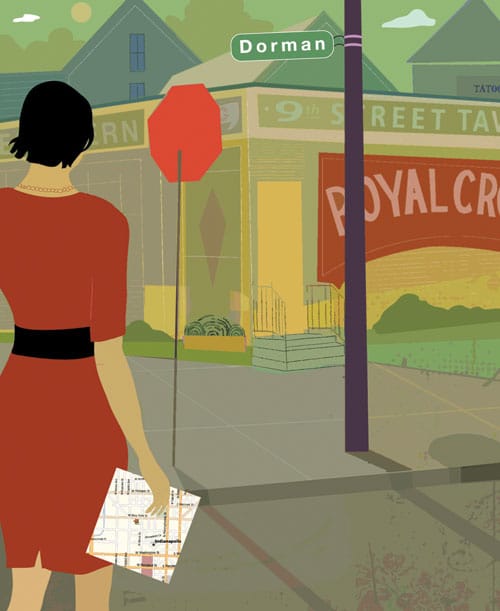
Map Quest
Some children aren’t satisfied with their names, but I always liked mine: Deborah Lynn Dorman. Or Debra Lynn Dorman—I was never sure, as my birth certificate says “Debra,” and somewhere along the way I decided to use the biblical version because it sounded more romantic. My mother waved away the inconsistency, saying I mattered to her far more than what I was called. Either way, the name had a melodic cadence, and I was proud to say it out loud. And unlike my given name, my surname was certain. Dorman.
Sure, other kids thought it was funny to ask me to hold open the door, but that joke wore thin. I never knew anyone besides relatives with my last name, so it felt unique. I later wondered if back in the old country it had been Dormanski or Dormananoff, a theory no one in my family could confirm or deny. Ancestors of those named Miller once made flour, and Weavers manned looms, so, now that I think about it, perhaps my classmates’ jabs had merit.
At some point in my early years I learned that a local street was named in my family’s honor, or so I surmised. Somewhere far from where I grew up in Meridian-Kessler, there was a Dorman Street. It was located near downtown, I was told, a ways from where my father was born on the city’s south side, and I imagined that being the eponym of a city thoroughfare would impart some degree of fame and fortune. Perhaps old-timers sat around on benches spinning tales about the original namesakes, and maybe establishments there bore our name: the Dorman Five & Dime or Dorman Savings and Loan. At those places, I thought, I would surely be recognized and given special treatment.
I never got to Dorman Street, though, and eventually I forgot about it. But a recent article on the Indianapolis Monthly website renewed my interest. Chris Eley, owner of foodie-acclaimed Goose the Market, was opening Smoking Goose, an artisan facility that makes Old World–style victuals, on Dorman Street. Even more epicurean trendsetters were located nearby (Flat 12 Bierwerks, Sun King Brewing Co., Easley Winery). “I see this area as a cultural food trail,” Eley said. Mass Ave might deserve such flattery, but little old Dorman Street? I had my doubts.
I needed to see the area for myself, so I cajoled the magazine’s food editor into joining me for lunch at what I learned was a noted landmark, the Dorman Street Saloon. It was originally called The Mahogany Bar, or “The Hog,” supposedly because the area was known for wood production during the Victorian era. According to legend, John Dillinger frequented it around the time of his heist of the State Bank of Massachusetts Avenue in 1933, when he made off with a record-setting $21,000.
My companion, knowledgeable about every culinary nook and cranny in the city, jumped at the chance to visit the funky neighborhood and said, “After lunch, we’ll get tattoos!” From the outside, the saloon was nothing if not authentic: dive-y and indigenous, the squat building enlivened by a Royal Crown Cola sign painted on the shabby wood siding. Unfortunately, the bar, beloved by Cottage Home natives and hipsters alike, was closed when we arrived, although a worker came to the door and said they had frozen pizza. We weren’t sure if she was apologizing or offering a meal, but in either case we appreciated the personal interaction: A closed sign on an Applebee’s would mean what it said.
Alas, since we passed on the pizza, we didn’t get to see the famous Rookwood tile bar or listen to the celebrated jukebox for ourselves. No matter: I was on Dorman Street at last, and I wondered, if only for a moment, how I might wrest the street sign from its steel post as a souvenir.
Since we were in the neighborhood, we decided to explore. We finagled our way into Smoking Goose and received a tour of the spic-and-span butchering facility, the warehouse thick with the fragrance of charred wood. The neighborhood itself appears not to have been yuppified or artificially turned trendy. No used-brick storefronts line the street; no one ambles about looking for a charming cafe or boutique. Rather, growth seems to be happening organically, the new neighborhood businesses relying on one another to spread the word. There are more dilapidated houses than slick fix-ups, although here and there a tidy wood-frame home has been remade to shelter-magazine standards. Two tiny early-1900s “kit houses” are worth seeing, although the neighborhood footprint—just a few side streets—is smaller than I thought my name would deserve.
Seeing the street I daydreamed about as a child motivated me to settle the old question once and for all: Was Dorman Street, in fact, named after my Dormans? According to historicindianapolis.com, Indiana’s fourth governor, Noah Noble, owned land in the area and named the street after his grandson, Dorman Davidson. Not only weren’t we considered, but the street didn’t even pay homage to a surname—oh, the indignity! Davidson, likely named after his maternal grandmother, Susan Dorman (aha!), married Virginia and had five children, one named Dorman Jr. The area was platted in 1865, Dorman Street was born, and Dorman Davidson ultimately moved to a residence on Michigan Road. He died in 1915 and is buried in Crown Hill Cemetery.
I’m going to visit his gravesite sometime, if only to see the name that, through his grandmother Susan, might yet be linked to mine. For now, though, I’m satisfied that the mystery surrounding Dorman Street is resolved, even if the fantasy is gone.
Illustration by Andrea Eberbach.
This article originally appeared in the May 2012 issue.





